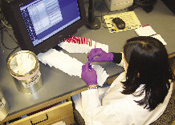Broad Research Portfolios
Broad Research Portfolios
Advancement of Imaging, Visualization, and Visual Comparison
Research new ideas and develop new techniques to advance imaging, visualization, and visual comparison for forensic studies, including specialized applications for microscopy, hyperspectral imaging, spectrochemical analysis, documents analysis, anthropology, and facial approximation.
Advancing Forensics
Advancement of forensic science through improved use of statistical analysis, application of automated pattern recognition technology, and studies on examiner decision reliability.
Application of Mass Spectrometry to the Chemical and Biological Sciences
Develop new techniques and improve existing methods for application of mass spectrometry (MS) analysis to the chemical and biological sciences, including techniques in toxicology, analysis of trace volatiles, genotyping via MS, and applications for isotope ratio analysis.
Biometric Research
Research in biometrics to advance analysis of intrinsic physiological human traits for the purpose of identifying groups and uniquely recognizing individuals, including studies with fingerprints, palm prints, DNA, RNA, proteins, human scent, and handwriting.
Case Work Unit-Specific Research, Development, Testing, and Evaluation
Short-term projects that directly address case work needs.
Decision Analysis and Validation Studies for Pattern-Based Disciplines
Research projects addressing the accuracy, reliability, and validity of pattern-based forensic science disciplines.
Detection, Analysis, and Identification of Biothreat Agents
Develop new techniques and improve existing methods for detection, analysis, and identification of biothreat agents, including pathogens, microbes, spores, viruses, and toxins.
Developing Techniques and Technologies
Research addressing the application of technological advancements and their application to forensic science disciplines.
Emerging Issues in Forensic Science
Discipline-specific research addressing urgent, emerging issues.
Explosives Detection and Analysis
Evaluate new technology and research methods for advancing characterization, detection, and analysis of explosives and explosives residues.
Field Portable Instrumentation
Evaluate new technology for the detection, collection, and characterization of evidence in the field.
Next Generation Sequencing (NGS)
NGS sequencing allows millions of DNA strands to be sequenced in parallel and DNA from multiple samples to be independently labeled and pooled so many samples can be sequenced in the same reaction. NGS holds the promise for analyzing degraded samples, detecting minor contributors in mixtures, and multiplexing hundreds of genetic loci. The Laboratory Division is interested in research aimed at evaluating NGS technology as a complement to existing forensic DNA analysis.
Trace Evidence Analysis
Advance the methods used for analysis of trace evidence, including microscopic and spectroscopic techniques as well as development and use of specialized databases for characterizing trace evidence.
08.16.10



